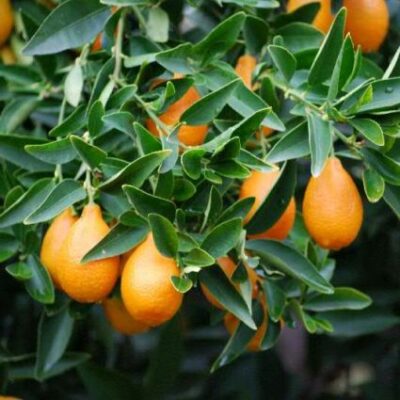Garden Plant: Indio Mandarinquat
Product Description: Indio Mandarinquat

Eat the Whole Indio Mandarinquat Peel and All
- Eat the Whole Thing
- Good Ornamental Lawn Tree
- Great in Containers
- Sweet/Tart Flavor
- Unique Introduction with Modern Appeal
Deliciously fragrant Indio Mandarinquat – as the name suggests – is a cross between a Mandarin Orange and a Kumquat. From its parents, it inherited a “grown-up” citrus taste – mostly sweet, with a little sour for balance, like a sour Mandarin.
It can be eaten whole, peel and all. The trick is to pick the beautiful, bell shaped fruit, wash them and toss them in your mouth. Chew, chew, chew to blend the sweet skin with the zingy flesh.
Like all Kumquats, the skin is where all the sweetness is. But the uniqueness is in the size and the Mandarin flavor of the Indio Mandarinquat, as well.
Fair warning! You might become addicted to the wonderful sweet/tart flavor that is part of the experience of eating this classic fruit. Yum!
Indio Mandarinquat is great for Chinese New Year as the fruit colors up at the same time as the popular Nagami. They are popular as a Marmalade or Preserve and to make rich, citrusy syrups.
People also juice them, then slice the peel and pulp together into salads to add a tangy zip. Save the juice to use as zippy cocktail mix in a glass with a sugared rim!
The Mandarinquat is high in vital nutrients. Because it is consumed whole, the skin’s highly nutritious essential oils and fiber make this a tremendously healthy fruit.
The fruit is bigger than a Kumquat but smaller than a Mandarin. They are bell-shaped with a nobby little end where they attach to the limb. Received as budwood in 1972 under the care of John Carpenter at the U. S. Date and Citrus Station in Indio, California, the Indio Mandarinquat has quickly gained popularity with all that appreciate a great flavored Kumquat fruit.
These will be a beautiful and delicious addition to your landscape.
How to Use Indio Mandarinquat in the Landscape
If you are lucky enough to live in Zones 8 – 10, you can safely plant them in the ground. They are naturally short, pyramid-shaped and covered in fruit from December to April. They’ll make gorgeous, ornamental lawn trees.
Consider planting multiples in a gentle curve along the length of an island garden bed in the yard. Or, use them as a low edible border along the length of a sunny fence.
Otherwise, if you live in a cold-winter climate, these perform exceptionally well in pots as an indoor/outdoor plant. Enjoy them as fun, fragrant Patio Trees all summer, then bring them indoors and place them near a sunny window to overwinter indoors. Keep them on the dry side indoors, as they won’t need much water.
Pro Plant Tips for Care
These trees require good drainage and can be pruned to any height. The fruit of the Indio Mandarinquat is persistent and once the tree is established, it is not uncommon to see fruit on the tree year-round.
However, this is not the case in colder climates when grown in a container as an indoor/outdoor plant. Being such a new selection, the information on indoor fruit ripening is not established, but other Kumquats typically ripen their fruit indoors successfully.
Make sure the container has plenty of drainage holes or drill additional holes as necessary. Raise up the container with bricks to ensure the bottom won’t sit in standing water. Use an acid based potting soil, such as Dr. Earth Acid Lovers Organic and Natural Planting Mix. To that, add a quarter Pathway Bark Mulch to the total volume of your container to improve drainage.
Indio Mandarinquats like slightly acidic soils, so be aware of the pH of your water. Collect rainwater where possible. Too high of a pH may result in yellowing leaves. Fertilize with an acid fertilizer, such as Dr. Earth Acid Lovers Organic and Natural Premium Fertilizer.
You’ll love this nutritious and beautiful plant – order today!


